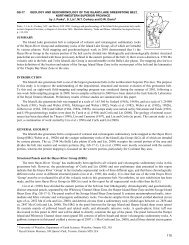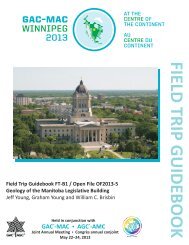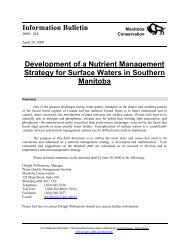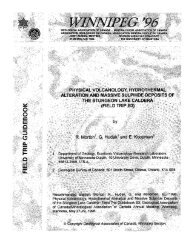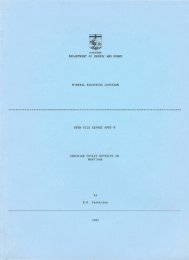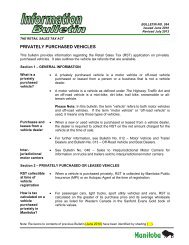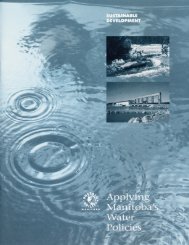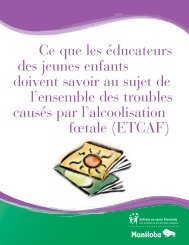Changes in the Emergent Plant Community of Netley-Libau Marsh ...
Changes in the Emergent Plant Community of Netley-Libau Marsh ...
Changes in the Emergent Plant Community of Netley-Libau Marsh ...
Create successful ePaper yourself
Turn your PDF publications into a flip-book with our unique Google optimized e-Paper software.
Vegetation change <strong>in</strong> <strong>Netley</strong>-<strong>Libau</strong> <strong>Marsh</strong><br />
Grosshans et al.<br />
m<strong>in</strong>ts (Mentha canadensis, Stachys palustris), purple<br />
loosestrife (Lythrum salicaria), and white asters<br />
(Symphyotrichum spp.). O<strong>the</strong>r representative species<br />
found <strong>in</strong> lower abundance are spotted touch-menot<br />
(Impatiens capensis) and western jewel weed (I. nolitangere).<br />
3G. Salt flats<br />
(Hordeum, Pucc<strong>in</strong>ellia)<br />
These are poorly dra<strong>in</strong>ed areas where soils are<br />
more sal<strong>in</strong>e, found where <strong>the</strong> water table is at or<br />
near <strong>the</strong> soil surface. These patches are <strong>of</strong>ten<br />
waterlogged <strong>in</strong> <strong>the</strong> early spr<strong>in</strong>g or have temporary<br />
stand<strong>in</strong>g water. Characteristic dom<strong>in</strong>ant species are<br />
foxtail (Hordeum jubatum), salt meadow grass<br />
(Pucc<strong>in</strong>ellia nuttalliana), slough grass (Beckmannia<br />
syzigachne), lamb’s quarters (Chenopodium album), sow<br />
thistle (Sonchus arvensis), and dock (Rumex spp.), with<br />
lower abundances <strong>of</strong> couch grass (Elymus repens),<br />
Canada thistle (Cirsium arvense) and whitetop (Scolochloa<br />
festucacea). Few salt flats areas occur with<strong>in</strong> <strong>Netley</strong>-<br />
<strong>Libau</strong> <strong>Marsh</strong>.<br />
4. Low prairie (temporary to no flood<strong>in</strong>g)<br />
4A. Grasses (Elymus, Bromus, Poa)<br />
(>75% grass cover)<br />
These are typical grassy lawns and meadows<br />
characterized by > 75% grass cover and < 25% forb<br />
cover. Soil moisture varies throughout <strong>the</strong> grow<strong>in</strong>g<br />
season. Mow<strong>in</strong>g or hay<strong>in</strong>g has impacted most<br />
grassed areas. They are typically dom<strong>in</strong>ated by low<br />
to <strong>in</strong>termediate grasses and forbs, <strong>in</strong>clud<strong>in</strong>g couch<br />
grass (Elymus repens), blue grass (Poa spp.), awnless<br />
brome (Bromus <strong>in</strong>ermis), sow thistle (Sonchus arvensis),<br />
Canada thistle (Cirsium arvense), and planta<strong>in</strong> (<strong>Plant</strong>ago<br />
major). Species <strong>in</strong> lower abundances <strong>in</strong>clude salt<br />
meadow grass (Pucc<strong>in</strong>ellia nuttalliana), foxtail (Hordeum<br />
jubatum), sedges (Carex spp.), spike rushes (Eleocharis<br />
spp.), and silverweed (Argent<strong>in</strong>a anser<strong>in</strong>a).<br />
4B. Grasses and forbs ( 50% grass and < 50% forb cover.<br />
They may experience brief flood<strong>in</strong>g to saturated soil<br />
conditions <strong>in</strong> <strong>the</strong> early spr<strong>in</strong>g, which is rapidly lost to<br />
seepage and evapotranspiration. Various areas have<br />
been impacted by cattle graz<strong>in</strong>g and hay<strong>in</strong>g at some<br />
time. Mixed grasses and forbs dom<strong>in</strong>ate <strong>the</strong>se<br />
meadows <strong>in</strong> vary<strong>in</strong>g proportions <strong>of</strong> dom<strong>in</strong>ance,<br />
typically blue grass (Poa spp.), awnless brome (Bromus<br />
<strong>in</strong>ermis), sow thistle (Sonchus arvensis), Canada thistle<br />
(Cirsium arvense), white asters (Symphyotrichum spp.),<br />
clover (Trifolium spp.), alfalfa (Medicago sativa), vetch<br />
(Vicia americana), marsh reed grass (Calamagrostis spp.),<br />
and sweet clover (Melilotus spp.). Less abundant<br />
species <strong>in</strong>clude reed canary grass (Phalaris arund<strong>in</strong>acea),<br />
couch grass (Elymus repens), timothy (Phleum pratense),<br />
salt meadow grass (Pucc<strong>in</strong>ellia nuttalliana), sedges<br />
(Carex spp.), western water horehound (Lycopus asper),<br />
and common m<strong>in</strong>t (Mentha canadensis). O<strong>the</strong>r species<br />
<strong>of</strong> low abundance are goldenrod (Solidago spp.),<br />
sunflower (Helianthus spp.), silverweed (Argent<strong>in</strong>a<br />
anser<strong>in</strong>a), Canada Anemone (Anemone canadensis), alkali<br />
cordgrass (Spart<strong>in</strong>a pect<strong>in</strong>ata), spike rushes (Eleocharis<br />
spp.), purple loosestrife (Lythrum salicaria), and sweet<br />
grass (Hierochloe odorata).<br />
4C. Prairie<br />
(>50% forb cover)<br />
These meadows are typical prairie fields<br />
dom<strong>in</strong>ated by upland grasses, herbs and shrubs,<br />
characterized by > 50% forb and < 50% grass cover.<br />
Flood<strong>in</strong>g <strong>in</strong> <strong>the</strong>se areas occurs only dur<strong>in</strong>g spr<strong>in</strong>g<br />
snow melt and heavy ra<strong>in</strong>s. Water is rapidly lost by<br />
seepage and evapotranspiration. A few areas have<br />
been impacted by cattle graz<strong>in</strong>g and hay<strong>in</strong>g. Mixed<br />
grasses and forbs dom<strong>in</strong>ate <strong>the</strong>se meadows <strong>in</strong><br />
vary<strong>in</strong>g proportions <strong>of</strong> dom<strong>in</strong>ance, which<br />
characteristically <strong>in</strong>clude awnless brome (Bromus<br />
<strong>in</strong>ermis), blue grass (Poa spp.), Canada thistle (Cirsium<br />
arvense), sow thistle (Sonchus arvensis), white asters<br />
(Symphyotrichum spp.), goldenrod (Solidago spp.), big<br />
bluestem (Andropogon gerardii), sunflower (Helianthus<br />
spp.), clover (Trifolium spp.), alfalfa (Medicago sativa),<br />
vetch (Vicia Americana), sweet clover (Melilotus spp.),<br />
marsh reed grass (Calamagrostis spp.), low prairie rose<br />
(Rosa acicularis), and planta<strong>in</strong> (<strong>Plant</strong>ago major). Species<br />
<strong>of</strong> lower abundances are couch grass (Elymus repens),<br />
Canada wild rye (Elymus canadensis), timothy (Phleum<br />
pratense), Canada Anemone (Anemone canadensis),<br />
western water horehound (Lycopus asper), common<br />
m<strong>in</strong>t (Mentha canadensis), silverweed (Argent<strong>in</strong>a anser<strong>in</strong>a),<br />
purple loosestrife (Lythrum salicaria), beggarticks<br />
(Bidens spp.), and common yarrow (Achillea millefolium).<br />
5. Upland (temporary to no flood<strong>in</strong>g)<br />
5A. Hayed grasses and forbs<br />
These are grass and forb meadows <strong>of</strong> class 4A,<br />
4B, and 4C that have been hayed. Mixed grasses and<br />
forbs found <strong>in</strong> <strong>the</strong> above classes characterize <strong>the</strong>se<br />
42 DMFS Occasional Publication No. 4



